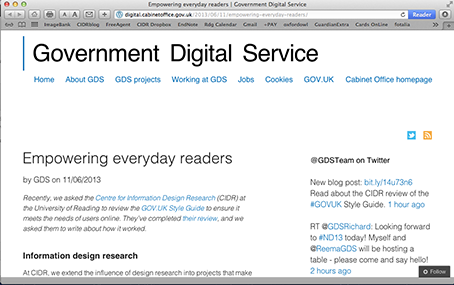Congratulations go to Part 3 students, Mel Towriss and Peter Loveland (pictured above) who, over the summer, took part in the University’s Undergraduate Research Opportunity Programme (UROP) and worked with Centre for Information Design Research. Their project examined how on-screen text format affected people’s reading speed and comprehension, as well as people’s views on which text formats were most appropriate for different purposes. The texts used for the study dealt with employers’ responsibilities to run a payroll and were drawn from the GOV.UK web site. Mel and Peter found strong agreement among study participants regarding the text formats; for example, what might be appropriate for beginner or professional readers of the information. Reading times for the different formats did not differ significantly across format but there were differences in comprehension of the information they presented. Mel and Peter were runners up in a research poster competition for all students taking part in the UROP scheme and will be taking their poster to the 2015 British Conference of Undergraduate Research.
-
Recent Posts
Recent Comments
Archives
- September 2018
- August 2018
- July 2018
- May 2018
- February 2018
- January 2018
- December 2017
- October 2017
- September 2017
- August 2017
- July 2017
- June 2017
- May 2017
- April 2017
- January 2017
- November 2016
- October 2016
- September 2016
- June 2016
- May 2016
- March 2016
- February 2016
- January 2016
- December 2015
- November 2015
- October 2015
- September 2015
- July 2015
- June 2015
- May 2015
- April 2015
- March 2015
- January 2015
- December 2014
- September 2014
- June 2014
- March 2014
- January 2014
- October 2013
- July 2013
- June 2013
- March 2013
- February 2013
- December 2012
- November 2012
- September 2012
- July 2012
- June 2012
- April 2012
- March 2012
Categories
Meta









